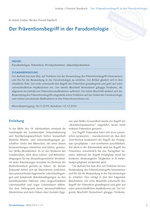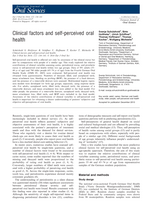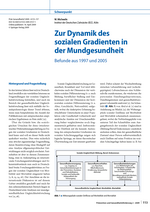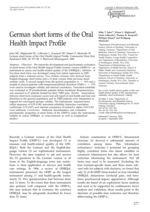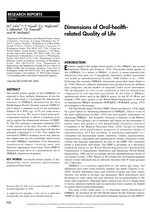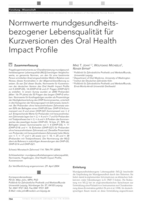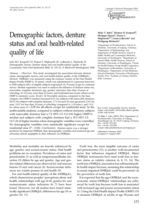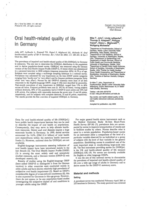
Medizinsoziologie und Gesundheitskompetenz
Autoren
Mehrstedt, Mats
John, Mike T.
Tönnies, Sven
Micheelis, Wolfgang
Schlagwörter
Dental anxiety
Dental health
Quality of life
Publikation — Zeitschriftenbeiträge
Titel
Oral health-related quality of life in patients with dental anxiety
Titel kurz
Community Dent Oral Epidemiol
Titel Ausgeschrieben
Community Dentistry and Oral Epidemiology
ISSN
0301-5661 (Print); 0301-5661 (Linking)
Jahr
2007
Ausgabe
35
Issue
5
Seitenzahl
357-363
Erscheinungsdatum
01.10.2007
Oral health-related quality of life in patients with dental anxiety
OBJECTIVES: To investigate the frequency of impaired oral health-related quality of life (OHRQoL) in patients with dental anxiety.
METHODS: OHRQoL was measured with the German version of the 14-item Oral Health Impact Profile (OHIP) developed by Slade and Spencer (1994) in 173 adult patients with dental anxiety [Dental Anxiety Scale (DAS) score 15 or above and Dental Fear Survey (DFS) score 60 or above]. The OHIP summary scores were characterized with an empirical cumulative distribution function and compared with the level of impaired OHRQoL in the general population (n = 2026, age: 16-79 years). In addition, OHIP item prevalences (responses 'fairly often'/'very often') were compared between patients and population subjects. The correlation between DAS, DFS and OHIP scores was calculated using the Pearson correlation coefficient.
RESULTS: A median value of 1 and a 90th percentile value of 13 were observed for general population subjects. In contrast, patients with phobic dental anxiety had a median OHIP-14 of 21 and the 90th percentile of 40. All problems mentioned in the OHIP-14 were more prevalent in patients than in population subjects. The most frequently occurring items in patients were 'self-conscious', 'life in general was less satisfying', and 'feeling tense' with prevalences of 50% or greater. In contrast, these items had prevalences of only 1-3% in the general population. A low to moderate relationship between OHRQoL and both dental anxiety measures (DAS and DFS) was observed (r = 0.25/0.26, P < 0.01).
CONCLUSIONS: Patients with dental anxiety/fear suffer considerably from impaired OHRQoL and the degree of this impairment is related to the extent of dental anxiety/fear.

